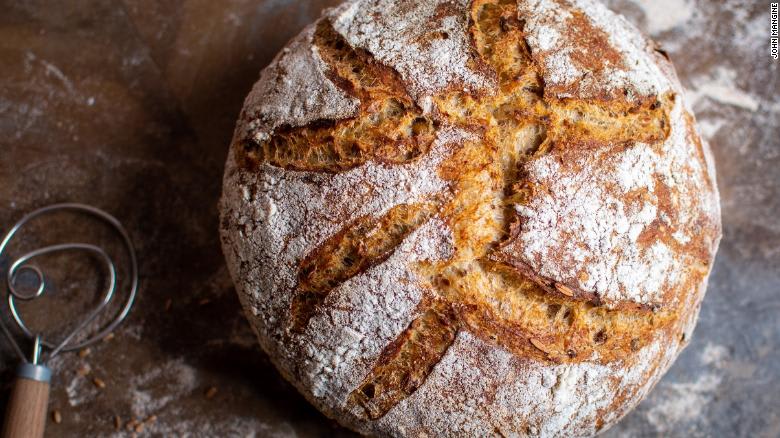دبي، الإمارات العربية المتحدة (CNN) -- لا يمكن للمرء إلّا أن يسيل لعابه، لمجرّد تخيّل خبز عجينة مُخمّر (Sourdough Bread)، ساخن، خرج للتو من الفرن.
وهذا الخبز الشهي، يمكن العثور عليه داخل كل منزل في الغرب تقريباً، لكنّ قلّة يعلمون أنّ صناعته تعود إلى آلاف السنوات.
وفي مناسبة صدور كتابه في 14 أيلول/ سبتمبر، تحت عنوان "ثفاقة الخبز المخمّر: تاريخ صناعته منذ القدم وصولاً إلى خبازي العصر" (Sourdough Culture: A History of Bread Making From Ancient to Modern Bakers)، تحدّث الخبّاز الهاوي إريك بالنت لـCNN كيف أنّ صدفة عمرها قرابة 30 سنة، أثارت اهتمامه بهذا النوع من الخبز ودفعته للبحث عن جذوره، وغيّرت مجرى حياته.
وكان بالنت في منتزه "كامبريدج سبرينغز" في ولاية بنسلفانيا الأمريكية، عندما تذوّق قطعة من خبز العجينة المخمرة المقرمشة، وأثار فضوله الطعم القوي ونسيجه الرقيق. وعندما استفسر من الخباز عن السبب أعطاه عيّنة من "العصية اللبنية" (الخميرة البيتيّة)، حتى يعيد صناعة هذا الخبز الشهي في المنزل.
وأمضى بالنت، الذي يشغل أيضًا منصب أستاذ محاضر في العلوم البيئة والاستدامة في جامعة "أليغيني كولج"، في منطقة ميدفيل الأمريكية، عقوداً يُطعم هذه "العصيّة" طحينًا وماء حتى تستمر، ويأخذ منها حاجته حتى يصنع خبزه الخاص.
وقال بالنت إنّ خميرته البيتيّة التي أخذها من الخباز في المتنزه تعود إلى 125 عامًا مضت، موضحًا أنها تُصنع من الطحين والماء، الذي يُنتج عنه مع مرور الوقت، فصائل عدّة من الخميرة، وبكتيريا جيدة تأكل النشويات في الطحين، وتُنتج حامض اللاكتيك الذي يعطي الطعم الحاد والغني في الخبز المقرمش، ويشكّل جيوباً غازية صغيرة ما يسمح للعجينة بالانتفاخ. ويمكن لهذه الخميرة الانتقال من جيل إلى آخر إذا تمّت العناية بها جيّدًا.
وأوضح بالنت أنّ اسم أوّل من صنع خبز العجينة المخمّر بقي مجهولاً لدى المؤرخين، الذين يعتقدون أن تاريخ صناعة العصيّة اللبنية يعود الى ستة آلاف سنة، بينما الخبز المسطّح يعود تاريخ صنعه إلى عشرة آلاف عام.
وأشار بالنت إلى أن الناس اعتقدت أن الفقاعات الناجمة عن مزج الطحين مع المياه التي تتسبّب بانتفاخ الخبز في الفرن، هي نتيجة سحر أو ظاهرة دينية، قبل أن يكتشف العالم الكيميائي الفرنسي والميكروبيولوجي لويس باستور في منتصف القرن التاسع مبدأ التخمير، وهو المسار الأساسي في صناعة العصية اللبنية.
وتعود نشأة هذه الخميرة البيتيّة، إلى الشرق الأوسط، وانتقلت إلى أوروبا ودول أخرى مع هجرة الناس الذين جلبوا معهم مهارات صناعة الخبز.
وذكر بالنت أنه كان لفرنسا دوراً رائداً، وخاصة أن الفرنسيين معروفين بتأنّيهم في صناعة الأمور، ومنها انتقلت إلى المكسيك وكاليفورنيا.
